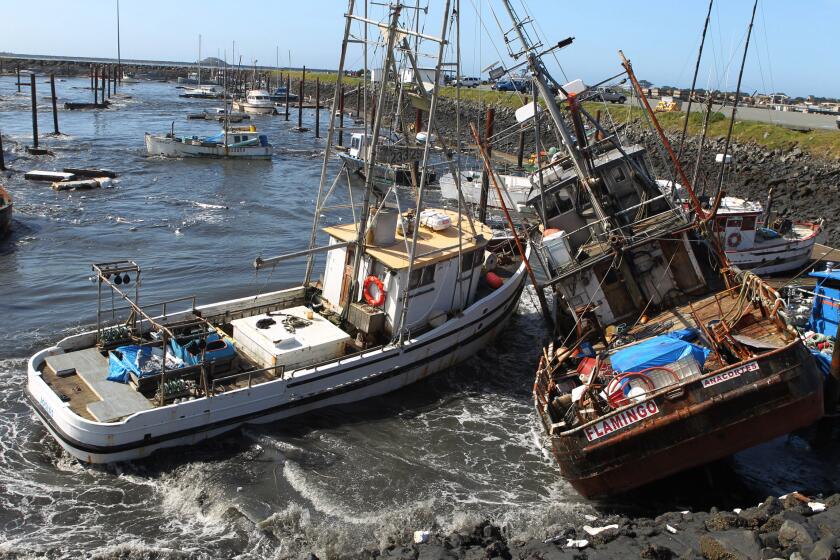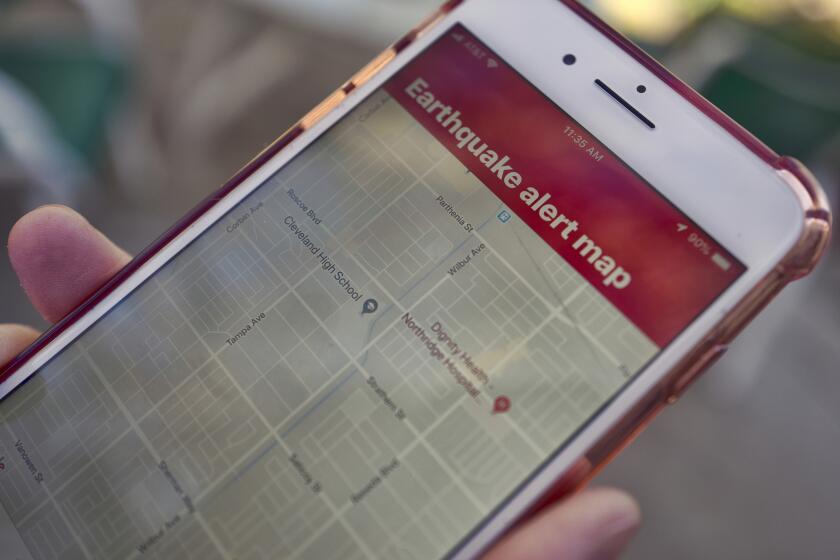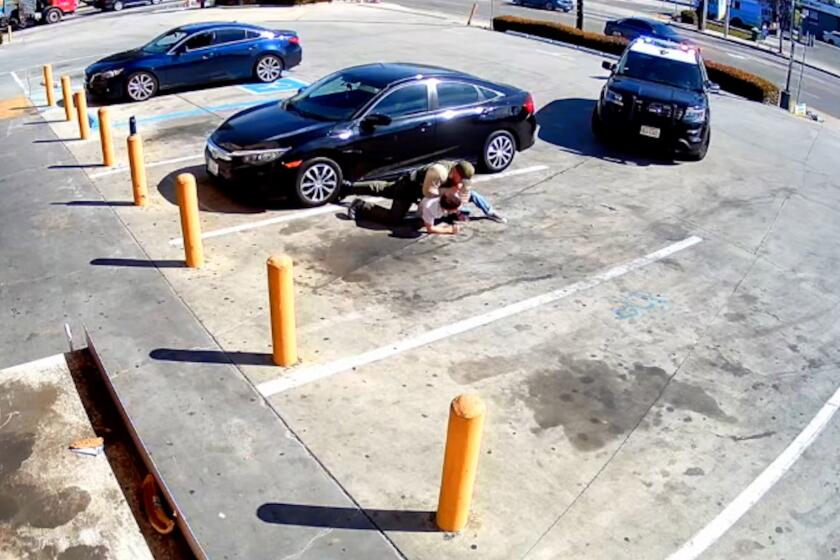WAITING FOR THE QUAKE : AT RISK: FREEWAY INTERCHANGES AND BRIDGES : Dozens of L.A. Freeway Structures Declared Hazardous : Transportation: Caltrans lists top priority projects in second phase of seismic safety program. L.A. County and city officials scramble to check out nearly 200 bridges.
The graceful, sweeping curves of the Santa Monica-San Diego Freeway interchange, seemingly a monument to engineering achievement, are now to the earthquake experts in the California Department of Transportation among the most vulnerable structures in the state.
Caltrans engineers, still maintaining even after last month’s disaster that California highway bridges are safe from collapse in a major temblor, acknowledge that the vital interchange, used by an average of 292,000 vehicles daily, could sustain substantial damage should an earthquake hit along the Newport-Inglewood Fault.
The interchange--along with dozens of other overpasses, underpasses, connectors, freeway ramps, pedestrian crossings, bridges and railroad passes in the Los Angeles County area--has been designated as a “high-risk” structure and given top priority by Caltrans for retrofitting in the second phase of a seismic safety program in effect since the early 1970s.
“The worst threat gets fixed first,” said James E. Roberts, chief of Caltrans structures division. “We wouldn’t expect any of them not to hold but we would expect a lot of them to be damaged, which might mean closing some routes. We want to upgrade them so we don’t even have to close them. We want to keep the lifelines open.”
An earthquake “planning scenario” published last year by the California Department of Conservation says that in those areas where shaking or liquefaction is most intense, even bridges that have been strengthened could be damaged. (The portion of the Nimitz Freeway in Oakland that collapsed had been reinforced in 1977 as part of Caltrans’ first phase of retrofitting.)
“The retrofit of a bridge does not guarantee against damage or collapse,” the Department of Conservation reported in its scenario.
City and county officials in Los Angeles say they are scrambling to inspect, repair and, in some cases, re-repair nearly 200 bridges under their jurisdiction. While none are as heavily traveled as the freeway corridors maintained by Caltrans, some of the city’s bridges are more than 50 years old. A few are architectural treasures and at least one of them is known to be decaying, according to City Engineer Robert S. Horii.
Horii said the city’s first priority is to reinspect the 4th Street and 6th Street viaducts, 50-year-old bridges that sluice traffic over the Los Angeles River between East Los Angeles and the city’s downtown. The 6th Street Bridge carries 12,000 cars a day, according to a 1977 traffic count which Horii’s office concedes is out of date. A 1986 traffic count estimated that the 4th Street bridge carries 27,000 cars a day.
Both structures are long--over half a mile--and about 70 feet high. At least superficially, they bear some resemblance to the portion of the Nimitz Freeway in Oakland that collapsed during the Bay Area earthquake, said Horii.
“Both viaducts are multicolumned structures, the kind of bridges that we are looking at carefully in the light of the Nimitz,” he said.
The two viaducts were strengthened after the 1971 Sylmar earthquake, Horii said. But the work that was done then involved reinforcing connections between adjoining decks that cars drive over. The viaducts were among 28 bridges scheduled for decking reinforcement after the Sylmar quake. About half of that bridge work has been completed. The rest is supposed to be done by 1992, Horii said.
Among the bridges left to do is one of the oldest in the city--the North Main Street Bridge which was built over the Los Angeles River north of downtown in 1910. Nominated for the National Register of Historic Places, the bridge was the first of its type--a triple-hinged, reinforced-concrete arched structure--built in the western United States. Today, it carries about 11,000 cars a day and is slowly deteriorating as a result of moisture seeping into the concrete arches, Horii said. He estimated that it will cost nearly $540,000 to repair and said the work is supposed to be done by 1991.
County officials say they plan to inspect 134 bridges of the 1,435 the county maintains.
The most heavily traveled of the 134 bridges are in Burbank at Hollywood Way over Vanowen Street and Hollywood Way over the Southern Pacific railroad tracks. More than 58,000 cars cross those bridges every day.
“We are looking at the ones that are supported by columns,” said Jim Noyes, deputy director of public works. Noyes added that none of the bridges are showing signs “that would indicate we need to take immediate action.”
Noyes said the county has spent nothing on seismic repair of bridges during the past decade. However, between 1971 and 1975, in the four years after the Sylmar quake, said Noyes, the county reinforced 225 bridges.
For highway engineers, Los Angeles is plagued with two conditions that make the seismic safety on bridges and elevated structures particularly worrisome--the county’s proximity to the Newport-Inglewood Fault and the heavy traffic congestion on its freeways. Those two factors, along with age and design, essentially determine the risk factor that is assigned to each structure.
As opposed to city engineers who are focusing on multicolumn bridges, Caltrans engineers say they will be paying most attention to single-column structures built in the 1950s and 1960s before the Sylmar earthquake.
Roberts said even the collapse of a multicolumn section of the Nimitz Freeway in last month’s earthquake has not changed engineers’ minds about the critical need for bolstering older, single-column bridges, particularly in the Los Angeles County area.
From the 1971 earthquake, engineers learned that they needed to make radical changes to strengthen the design of new bridges and begin a retrofitting program for older bridges. Bridges built after the San Fernando Valley disaster with the new design features have withstood subsequent earthquakes with little or no damage.
Likewise, structures built in the 1940s, such as the towering four-level interchange at the intersection of the Pasadena, Harbor, Hollywood and San Bernardino freeways, have proved safer than those constructed at the beginning of the computer age in the 1950s and 1960s.
“In the 1940s they didn’t have the computer technology and design theories to calculate stresses or loads as exactly as you can with a computer,” said Roberts, “so they tended to be conservative and maybe put a little more steel in and make members bigger.”
James H. Gates, structural mechanics engineer for Caltrans, said the extra steel tended to give the 1940s structures the reserve strength that is needed in a major earthquake.
“I looked at the plans of that (four-level interchange) and it’s fantastic,” Gates said. “I wouldn’t worry about it.”
Older bridges along the San Diego Freeway, perhaps more than any other, fit the profile of “high-risk” structures because they are heavily congested and close to fault lines. In addition to the Santa Monica interchange, engineers have attached high priorities for retrofitting to connector overpasses that carry traffic between the southbound lanes of the San Diego and the northbound lanes of the Long Beach Freeway and a San Diego Freeway overcrossing above Exposition Boulevard.
“You’re going right down the Newport-Inglewood Fault (on the San Diego Freeway) and that’s a critical fault for Los Angeles anywhere,” said Gates. “Everybody talks about the San Andreas but we think the Newport-Inglewood is the critical one. If you get a 7 on Newport-Inglewood you’re going to kill three times as many people as you would on the San Andreas.”
He said new evidence gathered by UC Berkeley engineers indicates that the collapse of the double-decked Nimitz Freeway that killed 41 motorists was caused by design defects in the joints between the top and the bottom level of the structure and not in the freeway’s multicolumn support system.
Last week, Caltrans dispatched a team of engineer-investigators to Los Angeles County to inspect bridges. From a review of hundreds of design plans, the investigators have determined that there are no structures in the area with similar joints.
“It’s a unique type of structure that exists in the Bay Area. We don’t see it in Los Angeles,” said Gates. “The average nuts-and-bolts multicolumn bridge statewide is still the least vulnerable bridge we’ve got.”
Gates said the Oct. 1, 1987, Whittier earthquake confirmed engineers’ suspicion that older, single-column bridges needed to be retrofitted. The retrofitting essentially involves sheathing the single columns in a steel blanket to literally hold them together during severe shaking.
In the Whittier quake only one bridge--the Interstate 605 separation over Interstate 5--suffered major damage. At the time, engineers said the bridge was saved from collapse only because it was a multicolumn; had it been supported by single columns “it probably would have collapsed.”
In memorandums issued after the Whittier earthquake to request $65 million for the second phase of the retrofitting program, engineers predicted that a major quake on the Newport-Inglewood Fault would subject at least 12 major freeways or freeway interchanges in Los Angeles to strong ground shaking. They said as many as 100 fatalities attributed to bridge collapses could result along with “traffic disruption” on the San Diego, Long Beach and San Gabriel River freeways.
When the memos became public after last month’s earthquake, engineers retracted the predictions, saying they had no “specific knowledge” that 100 fatalities could occur.
“(But) as long as there are older structures with details and components designed before 1971,” Gates wrote Roberts this week, “we will experience damage, some of which cannot be anticipated, and in all honesty we should continue to predict a number of fatalities in subsequent budget requests.”
In the event of a major earthquake either along the San Andreas Fault or the Newport-Inglewood Fault, experts anticipate major damage to the highway network in Los Angeles County as a result of landslides, liquefaction, roadway ruptures and bridge failures.
More to Read
Sign up for Essential California
The most important California stories and recommendations in your inbox every morning.
You may occasionally receive promotional content from the Los Angeles Times.










